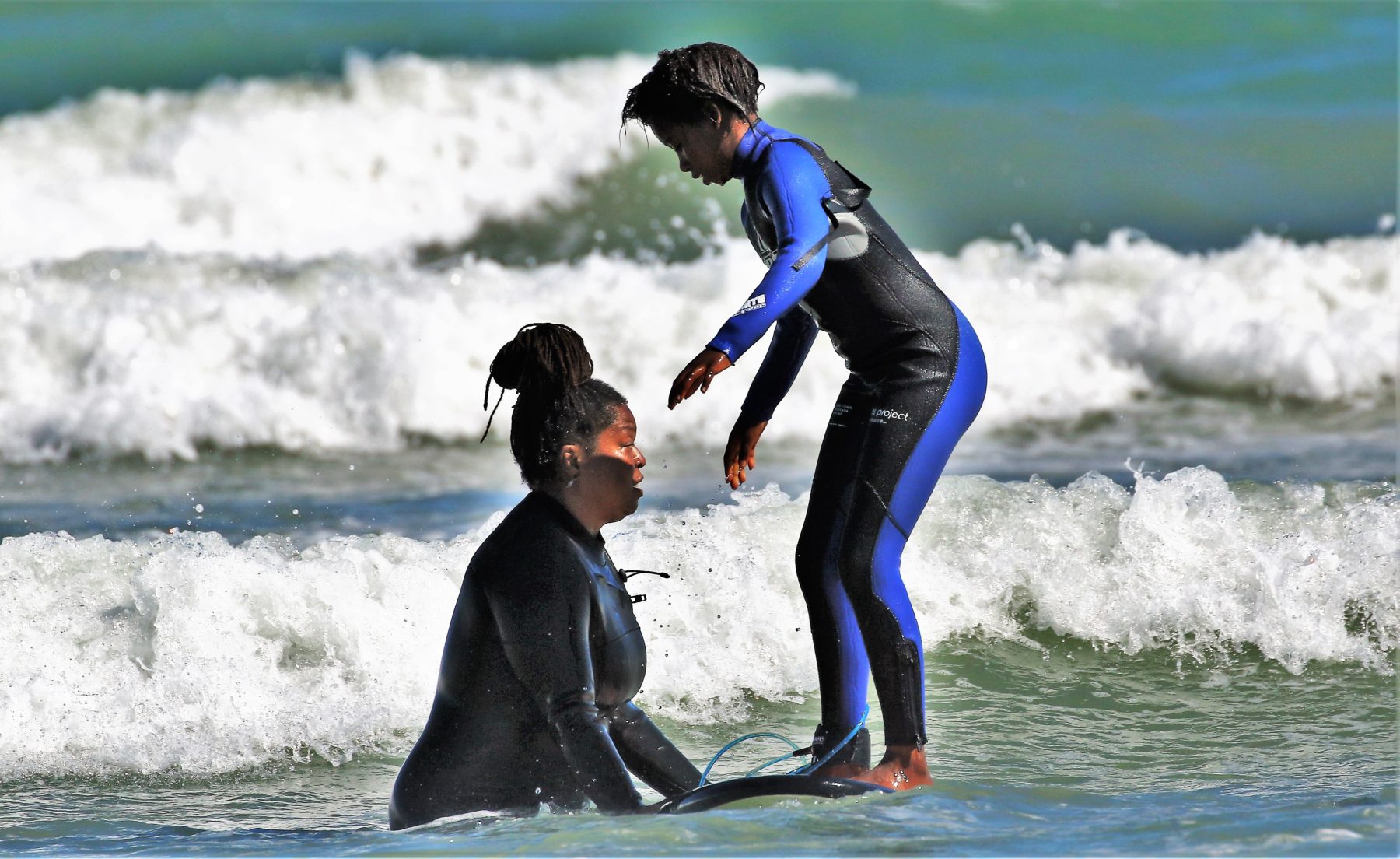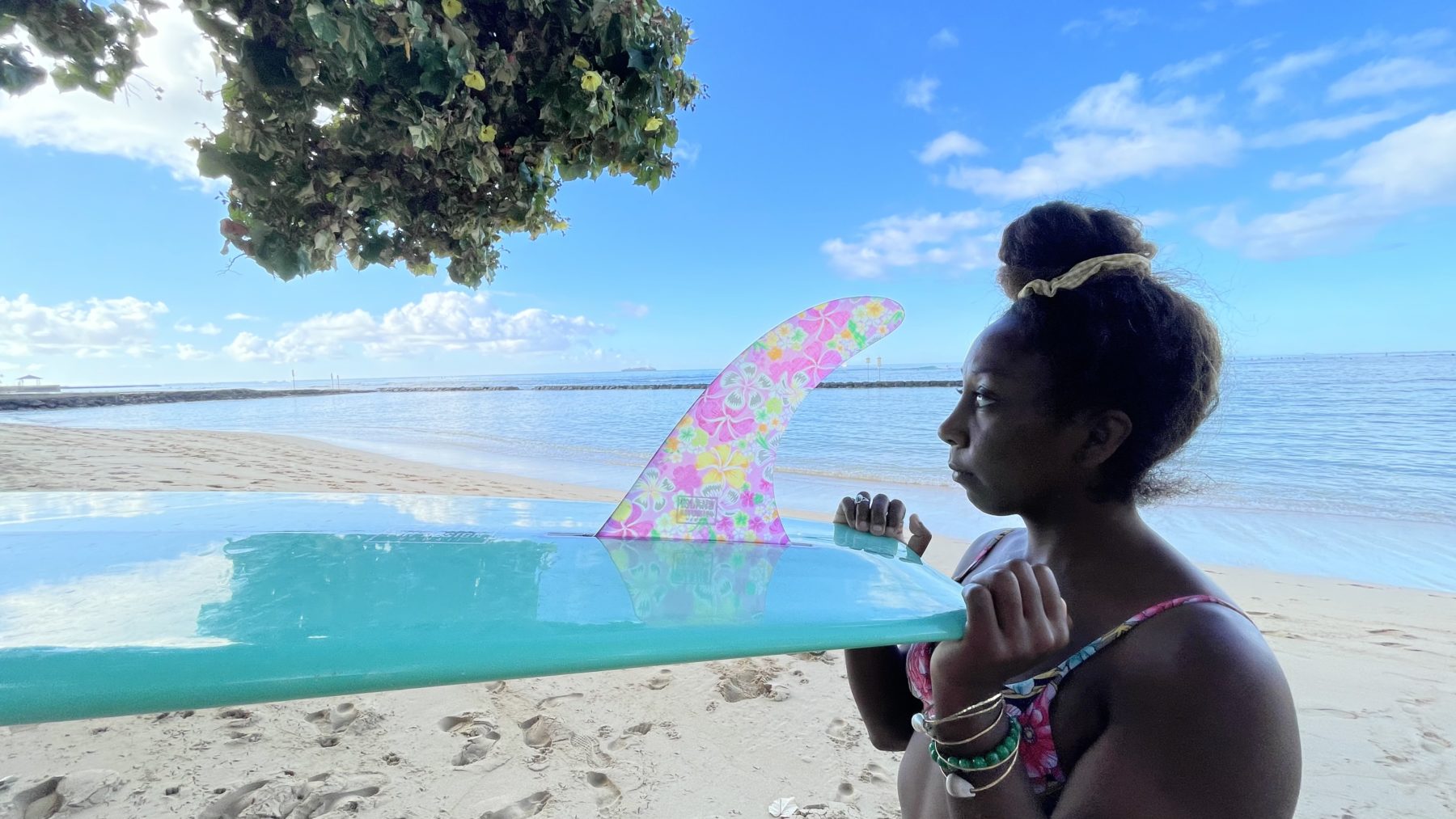Rhonda Harper stands waist deep in a black wetsuit, holding a surfboard steady in the hammering waves. Meanwhile, a young girl with a radiant smile, her Afro wet from the breaking surf, climbs onto the board, steps into a crouched position and, with a gentle push from Harper, rides her surfboard unsteadily to shore.
Harper, the 52-year-old founder of Black Girls Surf (BGS), a not-for-profit training program for Black women and girls, was running a surf camp in November at Standfontein Beach in Cape Town, South Africa. She was there to attend a surf therapy clinic run by Waves for Change, a nonprofit that uses surfing as a tool to help children of color from poor communities deal with poverty, crime and racism.
Harper is among a growing number of women of color promoting surfing as a recreational and professional sport for Black women and girls. Others include SurfearNEGRA, Textured Waves and Brown Girls Surf.

According to an article in Surfer Today, 23 million people surf worldwide, around 2.8 million of them in the United States.
There are no figures on how many are Black. But of the 261 female athletes on the Women’s Qualifying Series in the World Surf League (WSL), only a handful are nonwhite, including Anali Gomez of Peru, Bahia Frediani from Guadeloupe, who surfs for France and Rosanny Alvarez from Venezuela.
This is a reality Harper has been trying to change.
“My whole role in the beginning was just to make sure that we have somebody of African descent in the qualification series or the Championship Tour,” says Harper. “I wanted to showcase the diaspora so that these kids can get noticed.”
Harper held her first Black Girls Surf camp six years ago with two girls in her hometown of San Jose, Calif. Membership has steadily increased to over 100 girls in 10 countries, including Brazil, Sierra Leone and Senegal.
Her star pupil is Khadija “Khadjou” Sambe, Senegal’s first Black female pro surfer.
Sambe grew up on the island of Ngor, where the 14-year-old watched boys surfing in the distance. As a girl in a Muslim country, cultural norms dictated that she remain inside doing cooking and cleaning. Instead, she would sneak out after school, collect a beat-up surfboard she left hidden under her house and head beyond the reef to surf.
Four years later, after finishing school and becoming a surf instructor, Sambe caught Harper’s eye.
“I was flipping through this magazine with African surfers and this girl with long braids flowing down past her waist kept popping up,” says Harper. “She was surfing … 8-to-10-foot waves.”
Sambe traveled to California in 2018 to train with Harper. During a group training session at Venice Beach, a white male surfer came from behind and pulled the ankle cord of Sambe’s friend while she was catching a wave, causing her to fall. Sambe was shocked. She said she had never experienced such behavior in Senegal.
Harper posted the video of the incident on Facebook, and white surfers accused her making it about race.
There have long been racist reactions to Black athletes who integrated white-dominated sports. Jackie Robinson wore a metal plate in his baseball cap, and Althea Gibson was denied entry to hotels and restaurants while she traveled the pro-tennis circuit.
Lou Harris, who is African-American and surfs Rockaway Beach in New York, believes that racism mostly occurs on beaches that aren’t diversified.
“I’ve never experienced racism anywhere that I’ve surfed,” says Harris, who founded the East Coast chapter of the Black Surfing Association. “And people out here aren’t crazy; you couldn’t pull something like that and not expect to be called out.”
Sambe continued training, hoping to become the first Black female surfer to represent Senegal in the Olympics. Surfing would have made its debut in the 2020 Tokyo summer games, which were canceled because of the pandemic, putting Sambe’s dreams on hold.
“It’s my destiny to compete in the Olympics,” Sambe said in a FaceTime interview, as she sat in a hotel room in Kalk Bay on the Western Cape, wringing out her long, wet braids.
Harper provides support from sponsorships and fundraising to young professional Black surfers, whether they join her program or not, and gives her students free gear.
Pro surfer Monique “Nique” Miller, from Hawaii has benefited from Harper’s assistance.
“Nique is the African-American dream,” Harper says.
Miller, whose mother is first-generation Mexican-American and father is African American, is a striking figure with bronzed skin, hazel eyes and an almond-shaped face framed by waist-length, curly brown hair. She would like to eradicate the prevailing image of women who surf: thin, blonde, blue eyes and white.
“We’re not all stick figures,” Miller says while sitting on her lanai, cluttered with surfboards and fins.

Miller lives walking distance from Waikiki Beach on the island of Oahu, Hawaii, where she practices in the morning when most tourists are still asleep, and in the evening right before sunset.
At 5 feet 1 inch tall, Miller surfs in the classic longboarding style, standing upright, knees slightly bent for better balance, expertly tiptoeing like a ballerina back and forth across the length of the board as she rides the face of a wave
“The point of being a longboarder is to … be stylish and just go with the flow,” says Miller. “I might do a turn, walk back, or walk to the nose and hang 10. You let the waves dictate.”
While a student at the University of Hawaii, she competed in track. In her free time, she taught herself to surf, making friends with “beach boys” at Waikiki who let her borrow their surfboards. After graduating, she entered local competitions, often placing in the top five.
“I fell in love with surfing. I knew it was my destiny,” says Miller.
After turning pro four years ago, Miller has ranked third in world longboarding. She is now one of only a handful of Black female surfers competing professionally.
“Surfers in Waikiki are very diverse and I fit right in because I look Hawaiian, so I never felt like an outsider,” says Miller. “But it’s a white-dominated sport.”
Surfing is a costly sport. Boards run from $300 to $2,000, while wetsuits cost as much as $900. The annual expenses for competitive surfers are even higher because of travel and the number of boards they use.
To offset costs, Miller acquired a sponsorship with Billabong, an Australian surfing retailer that pays her to model its swimsuits. Billabong also covers all competition costs. “It took me a long time to get sponsored — a really, really long time — but I would see white girls who were not good surfers get sponsorships like that,” says Miller, snapping her fingers.
Miller was featured on the cover of Surfgirl magazine earlier this year, but most surfing magazines and websites have little, if any, representation of Black surfers. And surfing apparel and accessory sites such as Roxy and Ripcurl rarely use models and surfers of color. Surfgirl and the companies did not return calls for comment.
Surfing became a status symbol once it was brought from Hawaii to the mainland, says Jess Ponting, an avid surfer and assistant professor in sustainable tourism at San Diego State University. The 1959 movie “Gidget” popularized surfing, as did the growing Malibu Beach scene.
At Rockaway Beach, Harris knows that youth programs are key to changing that narrative.
“I want kids to see that surfers can be any color,” he says. “Give them the opportunity and see what happens.”
About the author(s)
Candace White is the Multimedia Producer at the Knight First Amendment Institute. She is responsible for developing the Institute’s multimedia and visual strategies for both online and print distribution and creating all media content.
During her 15-year career White was twice nominated for an Emmy Award. She produced content for several PBS series including Bill Moyers Journal, Earth on Edge, and Living on the Edge. She served as production manager for Half the Sky, which aired on PBS; producer and writer for CNBC’s Executive Vision 2010; and associate producer for MSNBC’s Special Edition. She also worked for other major media outlets including CBS, Lifetime Television, New York Times Television, and National Geographic Television.
White joined Columbia University in 2016, most recently serving as Media Production Manager for School of Professional Studies, where she worked with instructional designers and instructors to create multimedia course content for the school. Candace is pursuing her master’s in Journalism at Columbia University. Connect with her on Twitter: @canhwhite.



